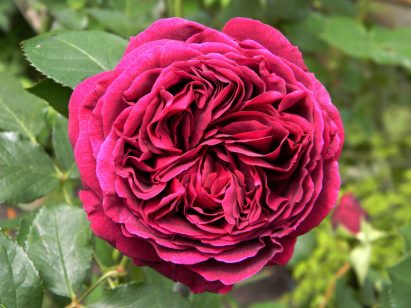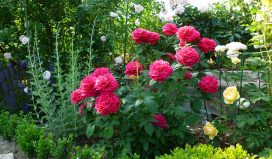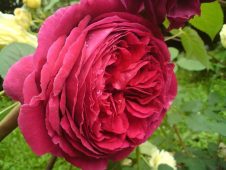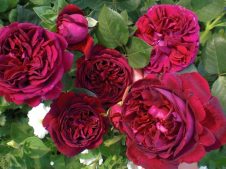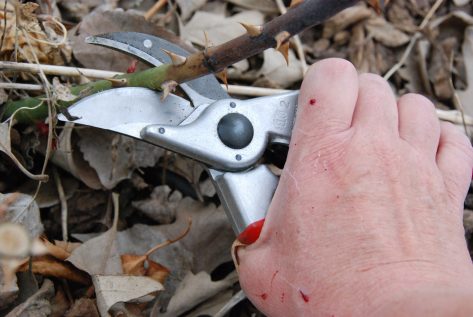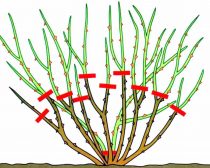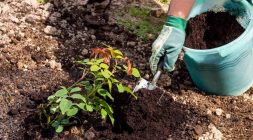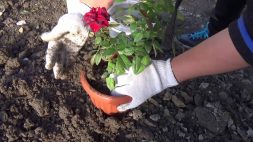Rosa Falstaff is a magnificent plant with a luxurious purple color of inflorescences. This variety is considered one of the most popular, because it combines amazing beauty and unpretentiousness in cultivation.
Material Content:
- 1 Description of variety and species
- 2 English plant variety
- 3 Climbing rose
- 4 History of flower breeding
- 5 Temperature features, lighting, humidity
- 6 Watering and feeding
- 7 Trimming and shaping a bush
- 8 Soil requirements
- 9 Flowering rose Falstaff
- 10 Pests and diseases - how to treat?
- 11 What problems can a flower grower face?
Description of the variety and species
The variety is distinguished by its magnificent large flowers with large, as if velvety, petals. They have a rich dark crimson hue with a purple tint. The aroma of such a rose is unique.
The bush has a straight shape with numerous branches. Its shoots can reach one and a half meters in height. The diameter of the bush grows to a meter. The branches are covered with small spikes, as well as bright green leaves.
The variety is well rooted, and also tolerates wintering. It is rarely prone to damage to aphids, powdery mildew, and other common diseases. It blooms during the growing season. If you believe the opinion of avid rose growers, the second half of the period is slightly weaker than the first, but in general also brings a lot of buds. They are collected by brushes of 4-5 flowers. A fully opened rose can reach twelve centimeters in diameter.
Variety Falstaff looks great in the garden until the end of flowering. The petals towards the center are darker, and brighten towards the edges, but at the same time retain saturated colors and velvety structure.
English plant variety
The English rose Falstaff was bred a very long time ago. It belongs to the category of hybrids of old varieties. It has an incredible aroma, as well as large, bright and velvety inflorescences, which are collected in clusters of several flowers.
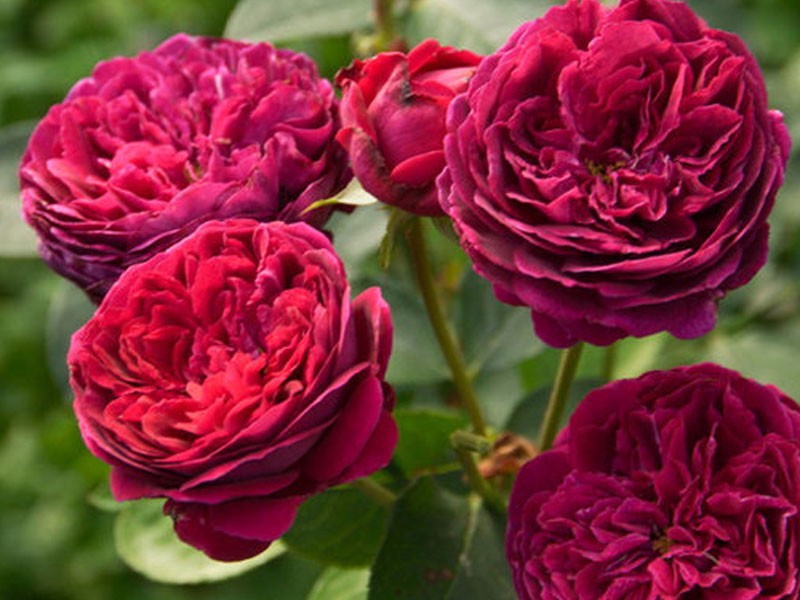 Climbing rose
Climbing rose
Rosa Falstaff is a climbing plant.It can be planted along fences, flower beds, as well as a chic living fence. In this case, you can not only decorate the site, but also enjoy the aroma emanating from roses.
The variety is popular in landscape design. With it, you can create romantic, contrasting compositions.
History of flower breeding
There are many breeders in the world, and each has made a contribution to the development of his industry. David Austin was a little-known breeder, but only until he brought out a hybrid of one of the most chic roses of past centuries, which once adorned the best yards.
There are hundreds of species of roses, but Austin's rose is Falstaff. The scientist believed that every rose he bred should surpass the previous work. And he was not mistaken. He managed to bring out a real miracle - an unpretentious, royally beautiful, fragrant plant.
The world first saw Falstaff in 1999. To date, the variety is considered unsurpassed and the best of all that the master managed to create. In his work, Austin took Floribunda as the basis, and then crossed it with tea hybrids and vintage rose varieties. All roses of the master are popularly called "Austin".
Today, David has his own large rose-growing company in England. During his work, he gave birth to about 200 new varieties, each year giving the world about 5 beautiful plants.
English roses, bred by this man, could long ago be attributed to a separate group, because they are most resistant to pests, cold weather and other unpleasant moments that can destroy a plant.
Hybridization takes about 8 years. During this time, roses are susceptible to a variety of influences in nurseries, including losing some special care. This is done to identify the survival ability of hybrids.
Falstaff is a variety that has passed all tests and received 4 years later the certificate of the Australian Adelaide competition. The name "Falstaff" rose was named after the favorite character of David - Shakespearean hero, companion of Henry IV. In catalogs, the rose is presented under the name "AUSverse".
Read also:what is hybrid tea roses
Temperature features, lighting, humidity
It is better to plant a rose in the spring. The earth should warm up to about 15 degrees. To bush rooted properly, you must carefully prepare the pit. It should be so large that the roots fit completely into it. Size 70 by 70 cm is ideal.
For seedlings of the variety, a plot is ideally suited for which there is no constant sun, and partial shade is present. Also make sure that there are no winds or stagnation of water at the location of the bush, as this is harmful to the roots.
Heat for roses is disastrous. They lose their strength, poorly flowering. If you plan to plant a bush near the fence, you need to retreat about 70 centimeters from it.
Despite the fact that the variety tolerates low temperatures, in very cold regions it is worth sheltering it for the winter. For normal variety growth, moderate air humidity is required.
Watering and feeding
This variety needs moderate watering. The basal circle should always be slightly moist. You will have to follow this, because otherwise the plant will not give the result that is expected of it. If the rose grows in loose soil, it will be very convenient to water it with the drip method. If there is no opportunity to build a drip system, then remember that one bush is watered with about two buckets of water.
It is impossible to irrigate the bush from above according to the principle of rain. Water pours under the bush, but not on the leaves and stems. If drops fall on them on a sunny day, then yellow spots will appear - burns.
For the first time, a rose is fed immediately after rooting. Humus is best. Fresh organics are not used as Falstaff fertilizer. The next top dressing will be in the fall, it is enough to do this once every 2-3 years.You can use organic fertilizers in the amount of 6 kg per shrub.
Minerals are another species that suits the variety as a fertilizer. It is better to use ready-made, but not made independently, previously diluted in water, as indicated in the instructions.
The most important minerals:
- nitrogen;
- phosphorus;
- magnesium;
- potassium.
Trimming and shaping a bush
To maintain the beautiful appearance of the plant, it must be trimmed. It is best to carry out the procedure in the spring. In autumn, this can weaken the shrub and it will be difficult for him to winter. The best dates are late March, April or early May, depending on the region.
Pruning can be sanitary and formative. Sanitary involves cleaning unnecessary branches that could dry after winter or just break off. Formative will make the bush a beautiful, neat decoration of the garden. First, dry and broken branches are removed, then shoots growing deep into the bush are removed.
And only then can you start cutting to a strong bud on the branches of several young shoots. All unnecessary branches are cut off until the living fibers of the plant appear. All sections are made 2-5 mm from the last kidney.
Soil requirements
The best soil for the variety is loamy soil. But in some conditions sandy loam will do. If rooting will occur in the fall, the bed needs to start to be prepared in a month. If the landing is planned in the spring, then it will have to be prepared before the start of winter.
The soil is loosened, and also mixed with humus and clay. If you know that your soil is poor, it is better to fertilize it with organic or bone meal. Also in some conditions superphosphate is suitable, but it is by no means added to acidic soils. If there is a lot of sand in the soil, weight it with a clay substrate.
Flowering rose Falstaff
Of course, the most beautiful in the variety is flowers, because it is for them that we love any roses. Falstaff has incredibly beautiful, looking and touch velvety flowers with rather large, rounded petals. When the flower is fully opened, it can reach 12 centimeters in diameter. They grow in small clusters from 1 to 5 buds.
Flowering continues throughout the growing season. This means that the bush pleases with its beauty for quite a long time. During this period, some inflorescences may dry out, but at this point, others will bloom.
The description of the flower can be this: it is large, bright, has a more saturated shade towards the center, closer to the burgundy with a purple tint, the edges are lighter. At the same time, the structure of the petal is very delicate, somewhat remotely similar to a tea rose.
Pests and diseases - how to treat?
The variety has medium disease resistance. For this reason, it is better to regularly carry out preventive measures so as not to harm the plant. In spring, it is best to spray the plant with copper sulfate. This is done approximately every two weeks.
The most common disease is rust. When a plant is affected by it, the stems and leaves become covered with red or brown spots. The bark begins to crack, and fresh shoots grow already twisted. In this case, Topsin-M and SCOR will become effective drugs.
The number one pest is green aphid. In a short period of time, it can destroy the plant. You can get rid of it by using a thick soapy solution, and then spraying it with drugs such as Commander, Alatar.
What problems can a flower grower face?
The greatest fear of a grower is considered to be aphids. She not only takes all the plant juices, but also contributes to the deformation of leaves, shoots and buds. Also, aphids can carry viral diseases, which will subsequently be difficult to cope with.
In order not to become a victim of this insect, in spring and autumn, the plant is treated with copper or iron sulfate. To do this, about 350 g of the substance is diluted in about 10 liters of water and sprayed with bushes.
Rust is another insidious disease that can occur in any season except winter. If you look closely, you can see on the leaves of the plant brown, orange or even almost black tubercles - these are pustules of the fungus.
The causes of the ailment may be several:
- too moist soil;
- excess nitrogen;
- lack of potassium and phosphorus.
It is necessary to deal with such an ailment by trimming the affected stems, harvesting old leaves, weeding weeds. It is also recommended to enrich the earth with ash fertilizers and treat the plant with iron sulfate at the beginning of the earth.
With proper care, problems with growing this variety of roses should not arise. He is considered very hardy and rarely affected by common rose diseases.


